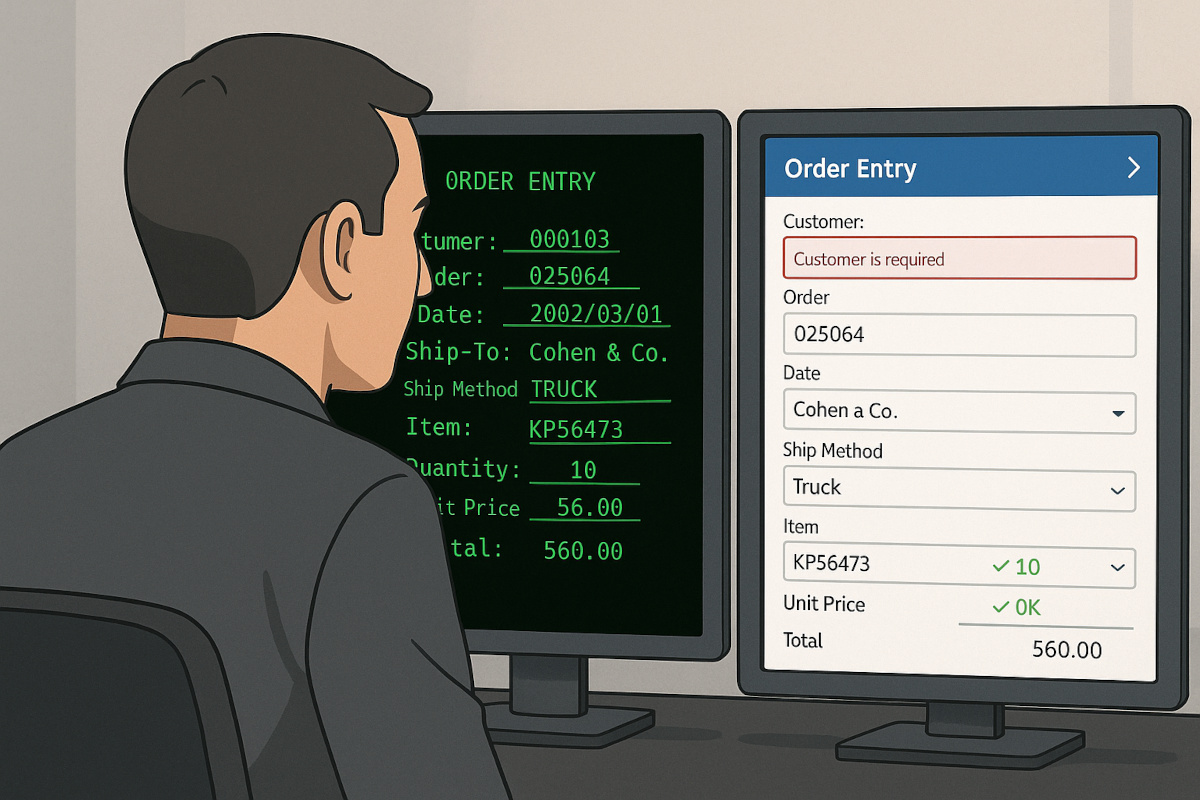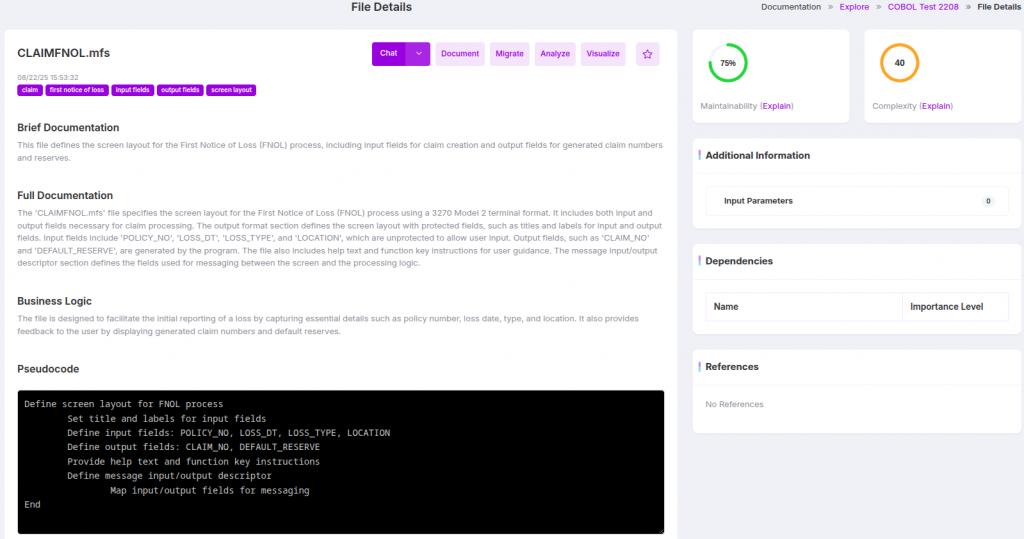Reimagining IMS/MFS Screen Documentation with CodeAura’s 3270 Simulation

IMS (Information Management System) and its associated MFS (Message Format Service) screens remain foundational to many transaction-heavy systems across regulated industries like banking, healthcare, and insurance. Despite the age of these technologies, they continue to handle high-throughput, business-critical operations where milliseconds matter and downtime isn’t an option.
Yet, as organizations look to modernize, one persistent obstacle stands out: understanding how these legacy systems actually work. IMS/MFS screens are not just user interfaces; they’re tightly coupled to back-end transaction logic, field validations, and data workflows. Without clear visibility into their structure and behavior, enterprises risk introducing compliance issues, migration errors, and costly downtime.
For IT leaders and modernization teams, gaining actionable insights into IMS/MFS environments is no longer optional. It’s a prerequisite for regulatory alignment, technical debt reduction, and knowledge continuity in an era when mainframe SMEs are rapidly retiring.
The Documentation Challenge
For decades, documenting IMS/MFS screens has been a slow, error-prone process—largely because it required direct access to the client’s mainframe. Without that access, teams had no reliable way to view a screen’s layout, navigation, or validation logic in context.
Instead, they resorted to fragile workarounds: screenshots saved in shared folders, outdated user manuals, or walkthroughs based on SME recollection. In regulated industries, where accurate process documentation is essential for audits and risk assessments, this approach falls dangerously short.
Compounding the issue, these artifacts rarely reflect the actual implementation. Screens evolve. Field rules change. But documentation often lags behind—leaving developers, auditors, and business analysts without a single source of truth.
CodeAura’s AI-Powered Documentation
CodeAura eliminates the historical bottlenecks of IMS/MFS documentation with an AI-driven approach that requires no live mainframe access. Instead of relying on terminal access or legacy tools, our platform analyzes MFS source artifacts directly—generating rich, structured documentation from the actual codebase.
This includes:
- Full screen layouts with accurate field placements
- Navigation flows between screens
- Input/output field rules, including conditional behavior
- Validation logic enforced at the field level
All documentation is version-aware and automatically synchronized with code changes, eliminating the risk of outdated or orphaned artifacts. Teams can now access detailed, living documentation at any point in the development or audit lifecycle. This enables seamless onboarding, faster compliance responses, and confident modernization planning—without ever needing to touch a mainframe console.

Interactive 3270 Simulation
CodeAura goes beyond static documentation. It provides a fully interactive simulation of IMS/MFS screens that behaves just like a live 3270 terminal—without requiring any mainframe access.
Users can click through screens, enter sample data, and see validations fire in real time. This makes it possible to test, learn, and document transactional flows with precision.
Our 3270 simulator enforces all the constraints defined in the original MFS artifacts:
- Field length restrictions
- Uppercase-only input rules
- Required field validations and error feedback
- Conditional navigation logic
This simulation becomes invaluable across teams: developers use it to understand real-time behavior, analysts use it for process verification, and compliance officers can validate exactly how sensitive data is captured and routed—without ever touching the mainframe.

Why This Matters
Understanding IMS/MFS behavior isn’t just a developer concern—it’s a cross-functional imperative. CodeAura’s simulation and documentation capabilities unlock value across the enterprise:
- For Developers: No more waiting for access to a restricted mainframe environment. New engineers can understand screen flows, validate field behaviors, and test integrations directly within CodeAura’s platform.
- For Business and Compliance Teams: Visually confirming how and when data is collected—especially PII, PHI, or financial records—is critical for demonstrating regulatory adherence. CodeAura provides a transparent, testable trail.
- For Modernization Teams: During migration, interactive simulations serve as both reference and regression test bed. Teams can compare mainframe logic to new cloud-based implementations and verify functional parity before go-live.
This shift from opaque, access-restricted environments to open, interactive, and traceable documentation reduces project risk and accelerates value delivery.
Use Cases
CodeAura’s IMS/MFS capabilities aren’t theoretical—they’re being applied in real-world modernization and compliance initiatives across regulated industries. Here are a few common scenarios:
- Training Without a z/OS Footprint: Onboarding new developers to legacy systems no longer requires provisioning expensive mainframe environments. CodeAura delivers the full screen interaction experience in a browser, shortening ramp-up time and reducing infrastructure overhead.
- Parallel Testing During Migration: During COBOL-to-Java or mainframe-to-cloud transitions, teams can run side-by-side comparisons between legacy behavior and modern implementations. This enables faster defect identification and increases confidence in cutover timelines.
- Audit-Ready Documentation for Compliance Reviews: Whether for HIPAA, PCI-DSS, or Basel IV, showing how data is captured, validated, and routed through a system is now as simple as presenting a CodeAura simulation. Every screen interaction and validation rule is transparently documented and provable.
These use cases highlight a core shift: IMS/MFS understanding is no longer trapped inside legacy systems or SME knowledge. It’s now inspectable, testable, and available on demand.
Conclusion
IMS/MFS screens have long represented one of the most opaque—and risky—areas of legacy infrastructure. For enterprises managing regulatory pressure, workforce transition, and digital modernization, the lack of visibility into these systems has stalled progress and increased operational risk.
CodeAura transforms this landscape. By converting IMS/MFS documentation into a living, interactive experience, we enable teams to understand, simulate, and modernize critical transactional flows—without ever needing live mainframe access.
This capability accelerates modernization timelines, improves compliance posture, and secures institutional knowledge for the future. Legacy doesn’t have to mean locked-in.
Let’s Talk About Your MFS Documentation and Modernization Needs — Schedule a session with CodeAura today.

